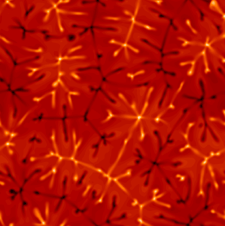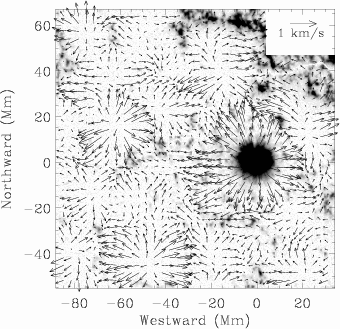
PhD projects are offered and supported by any one of the institutes in the Research School. Supervising scientists not affiliated with one of the partner universities share the supervision with a faculty member. The thesis will be written in English; students are expected to publish at least two papers in refereed journals during their PhD period.
A Thesis Advisory Committee (TAC), to be named at the beginning of the thesis work, guides the student through the preparation period and monitors her/his work. The TAC consists of the thesis supervisor and one or two other senior staff members of the institutes involved in the research school. At least one of the members must be a regular professor at the university at which the student is inscribed.
The following list gives an overview of the variety of research topics, but it is not complete. Some projects may already be taken, and others not mentioned will be available.
Solar-like oscillations are caused by sound waves, excited by turbulent convection, that are trapped within a star. The purpose of helioseismology is to observe and interpret solar oscillations to learn about the internal structure and dynamics of the Sun. The data from the MDI telescope aboard the ESA/NASA SOHO satellite have yielded numerous exciting results. In particular, the validity of the basic standard model of stellar structure has been confirmed, and rotation has been mapped as a function of depth and latitude in the convection zone. Current studies focus on new techniques of local helioseismology to produce three-dimensional maps of the subphotospheric flows and temperature inhomogeneities. Possible thesis topics include the development and implementation of diagnostics tools of local helioseismology to probe the internal structure of sunspots and the dynamics of convective flows. Below is a map of horizontal flows around a sunspot, 1 Mm beneath the solar surface.

Helioseismology is a growing field of research, with several missions planned for the future (HMI, Solar Orbiter). In addition, solar-like pulsations have recently been detected on other stars than the Sun from ground-based observatories. It is hoped that high-precision stellar seismology will become a reality with the ESA space mission COROT.
[top]Inverse methods allow us to use observed wave travel-time shifts to infer subsurface physical conditions. One particular target for inversions is near-surface supergranulation-scale convection. For example we can detect the subsurface extension of the moat flow around sunspots as well as the subsurface supergranulation flow pattern. Flow maps of this type will help us study the connections between subsurface flows and magnetic field evolution in the photosphere.
[top]Convection is the mechanism by which energy is transported through the outermost 30% of the Sun and plays an important role in models of stellar structure and evolution. In the past, our understanding of deep solar convection has been based on theoretical models and numerical simulations. Recently, however, a new method for using helioseismology to study the statistical properties of convection in the deep solar convection zone has been developed. We have found that current numerical simulations of large-scale convection carried out with the commonly employed Anelastic Spherical Harmonic (ASH) code substantially overestimate horizontal convective velocities. In addition, the upper limit provided by helioseismology is below the theoretical lower limit on convective velocities that follow from demanding that the convective Reynold's stresses be strong enough to maintain the observed solar differential rotation and meridional flow. Thus helioseismology observations appear to be a substantial challenge for models of subsurface convection.
[top]Sunspots are an important observational element of the solar magnetic cycle: they are the most notable product of the emergence of flux from beneath the solar surface. They are well observed at the surface, but where they come from and how they are attached to, or disconnected from deeper structures remains a matter of speculation. Helioseismology is the only tool with the capacity to move from speculation to observational knowledge.
[top]The solar dynamo produces magnetic activity that rises and falls in an approximately 11 year cycle. Some of the cycles are very active; some are weak. What causes this variation in the strength of cycles?
[top]An important goal of asteroseismology is to accurately determine the properties of individual stars. Asteroseismology constrains stellar models and informs our understanding of how stars and their planetary systems form and evolve.
[top]The transport of angular momentum in stellar radiative zones is not well understood. Angular momentum is transported in stellar radiative zones by mechanisms such as meridional circulation, turbulent viscosity, magnetic fields and internal gravity waves. Such mechanisms have been modeled with several prescriptions and applied to stellar evolution codes. Transport by meridional circulation and turbulent viscosity, in particular, has been used to study the rotation profiles of main-sequence and red-giant stars. Until recently, however, direct information on the core rotation was not available. Thus, direct comparisons with observation were not possible. This has recenttly changed opening up a number of interesting possibilities.
[top]The cool Sun is surrounded by a hot outer atmosphere. This million K hot corona is heated through conversion of magnetic energy, even though the details of this process are not well understood. In the "coronal dynamics" group we investigate the dynamics, structure and heating of the corona with the help of numerical model, e.g. 3D magnetohydrodynamics (MHD) models that account for the interaction of the magnetic field and the plasma. Using high-performance computing we simulate the processes in the corona and synthesize the coronal emission in the extreme UV and X-rays. This allows us to directly compare out models with real observation of the Sun. In this framework several topics are available for a PhD thesis, including the implementation of new physical processes into the numerical models, parametric studies of the response of the corona to the driving from the solar surface, or the synthesis of emission lines for comparison with actual space observations, e.g., from Hinode, SDO or the upcoming IRIS mission.
[top]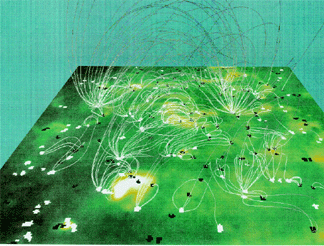
The Solar magnetic field is a major factor organizing the release of plasma and wave energy from the Sun into the heliosphere. Using modern magnetographic techniques, in part under development at the MPAe, the full Solar vector magnetic field information is becoming available at higher resolution than ever. Since direct measurements of the solar magnetic fields are restricted to a thin layer close to the Solar surface the fields have to be extrapolated to the Solar atmosphere (Figure). To understand the consequences of these fields for the heliosphere, however, one has to consider also the plasma of the Solar atmosphere in its interaction with the magnetic fields. For this purpose the PHD project aims at the development of computer models, starting with the search for appropriate equilibria. The combination of equilibrium configurations with the measured magnetic fields should provide realistic plasma models which then will be used to simulate, this way trying predict the evolution of Solar plasmas and fields. It is planned to compare the results of this modelling effort with existing observations of the SOHO spacecraft where the MPAe is heavily involved, in the future with the STEREO and other Solar missions.
[top]
Reconnection is the main physical process of plasma heating and particle acceleration by utilizung the energy stored in magnetic fields In the "Theory and simulation of Solar system plasmas" (TSSSP) group appropriate methods are being developed to simulate the dynamics including plasmakinetic effects. The latter have to be taken into account since in the collisionless and complex space plasmas direct interaction between particles are rare and collective effects therefore prevail. The resulting physical effects are highly nonlinear. They can be best described by numerical simulation techniques. In the TSSSP group at MPAe different types of codes have been developed which can be applied using powerfull parallel computing facilities. One of the PHD projects in this direction is to investigate the consequences of three-dimensional reconnection (Figure) for the dynamics of the Solar atmosphere, particle acceleration into the Solar wind and radiation. A special role which has to be investigated plays the magnetic helicity, a remotely measurable quantity, its creation, evolution, transport since it might enable us to predict Solar eruptions and their consequences for the space wheather at Earth.
[top]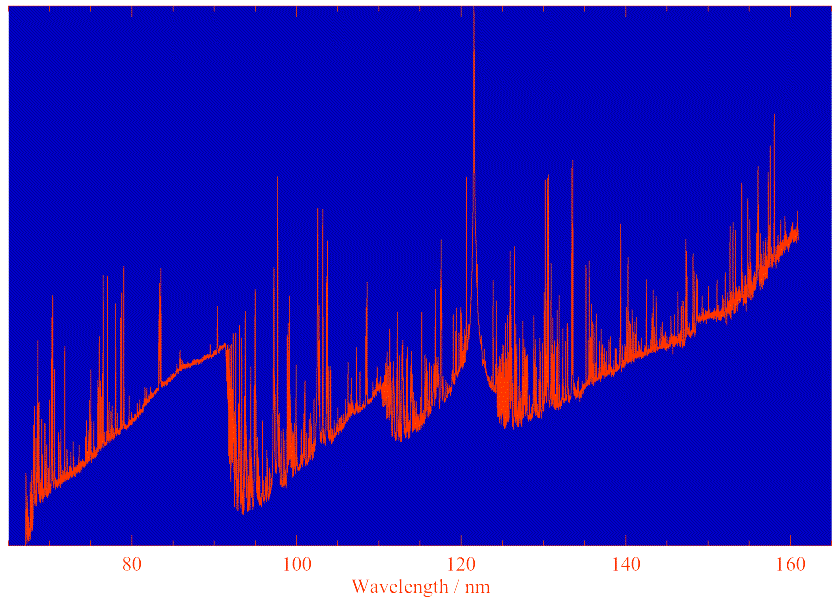
The
solar VUV spectrum from 50 nm to 160 nm recorded by SUMER
It was the combined development of spectroscopy and atomic physics that led, at the end of the thirties of last century, to the discovery of a hot (over one million K) corona above the cool (5780 K) solar photosphere. Since then, the development of the available instrumentation and atomic physics calculations have provided an increasing sophisticated and powerful tool for the study of the solar and stellar coronae.
|
The low density (about 109 electrons cm-3), optically thin coronal plasmas emit a spectrum dominated by emission lines (generally due to exitation by electron collisions and subsequent spontaneous decay) and continuum. This radiation is function of the thermodynamic state of the emitting source (i.e., density and kinethic temperature of electrons and element abundances). Thus, the knowledge of the atomic processes leading to the formation of lines and continuum coupled to the measurement of the emitted radiation allows the characterization of the emitting source. Spectroscopy, in particular, besides isolating specific emission lines, allows the measurements of plasma motions on scales larger (bulk motions leading to Doppler shift of the entire line) and smaller (modification of the line profile) than the spatial resolution, providing information on the dynamics and mass transport in the atmosphere. Moreover, being the coronal plasma forced to move along the magnetic field lines, the radiance and velocity patterns trace the magnetic field well above the photosphere, in regions where cannot be measured directly. The Figure on the side shows an example of velocity maps obtained by SUMER. In this case the target was a large sunspot, but such studies can be performed on any other region of the Sun. |
|
The coronal emission falls almost entirely in the vacuum ultraviolet (VUV: 10 to 200 nm). Thus, the study of solar and stellar coronae requires space instrumentation. The VUV group at MPS is very active on this research topic. It has built and operates the SUMER spectrograph aboard the SOHO spacecraft and is involved in several other important present (Stereo) and future (Solar Orbiter) solar space missions.
[top]In-situ dust detectors on board the interplanetary spacecraft Ulysses, Galileo and Cassini have measured interstellar dust particles in the solar system. The grains originate from the Local Interstellar Cloud (LIC) outside our solar system and they act as tracers of the physical conditions in the LIC. In the inner solar system the interstellar dust stream is altered by the solar radiation pressure force, gravitational focussing and interaction of charged grains with the interplanetary magnetic field. Cosmic dust is an important player in many astrophysical processes like, for example, proto-planetary accretion discs and the formation of planetesimals. The physical processes involved in cosmic dust are of far-reaching significance. The PhD thesis deals with the interpretation of the Ulysses interstellar dust measurements and modelling the grain interaction with the heliosphere, in particular with the time-varying interplanetary magnetic field. The implications for the physical conditions of the LIC shall be assessed.
[top]Water vapour plays a crucial role in the ozone chemistry of the middle atmosphere of the Earth since it is the source gas for hydroxyl radicals. With increasing altitude in the middle atmosphere the hydroxyl catalytic cycle starts to dominate ozone depletion. The SPARC (stratospheric processes and their role in climate) water vapour assessment of the WMO-World Climate Research Programme reported a 50 to 100 % increase of water vapour in the middle atmosphere since the 1950s which can only partly be explained by anthropogenic influences like the strong increase of methane (which is oxidized to water vapour). We would like to investigate the influence of the solar ultra violet variability on the middle atmospheric water vapour and ozone (see related program: http://www.bu.edu/cawses/germanymay2005.htm). While the total solar irradiance only changes by < 0.1% over a solar cycle, the Lyman-alpha radiation, mainly responsible for water vapour photolysis, typically varies by a factor of 2. Recent theoretical work proposes atmospheric coupling mechanisms that should result in a time delayed effect of solar ultra violet variability on the middle atmospheric water vapour and ozone concentrations. The MPS is running water vapour and ozone microwave spectrometers (see: http://alomar.rocketrange.no/water-vapor.html) covering a period of nearly one solar cycle that provide unique, high quality data sets. The purpose of this PhD project is to analyze these data sets with respect to the context mentioned above and to compare the findings with the model predictions.
[top]The Herschel Space Observatory (see: http://sci.esa.int/science-e/www/area/index.cfm?fareaid=16 and http://herschel.jpl.nasa.gov/) will be launched in summer 2007 and will start its observations right away. The MPS as part of the instrument teams plays a leading role in using Herschel for solar system investigations. Specific topics covered by our guaranteed observation times concern the origin of water in the upper atmospheres of the outer planets, the Martian water cycle, the chemistry of the Martian atmosphere, and search for water in distant comets, water excitation and the D/H ratio in comets. Already in 2006 we expect to perform first science flights with SOFIA (see: http://www.sofia.usra.edu/ and http://www.irs.uni-stuttgart.de/aktuelles/). With our hardware contribution to the GREAT-instrument (see: http://www.sofia.usra.edu/Science/instruments/instruments_great.html) we intend to address similar scientific and/or complementary topics by observing solar system objects in the THz range of the electromagnetic spectrum. Depending on the qualification and interests of the applicant(s) the PhD project(s) would either focus on a planetary or cometary topic with some preference for the latter.
[top]The atmospheric circulation on Mars is driven by a complex interaction between the radiative, photochemical, and dynamical processes. General circulation models (GCM) of the atmosphere have long been a powerful tool for studying these processes on Earth, and now they are becoming increasingly important for Mars. A new state-of-the-art Martian atmosphere GCM has recently been developed in MPS within the framework of the Mars Atmosphere Observation and Modeling (MAOAM) project. We have PhD opportunities which will focus on improving physical parameterizations in the model, assimilating data from space missions, airborne and ground based measurements, and carrying out numerical simulations to understand the Martian global circulation and its variability.
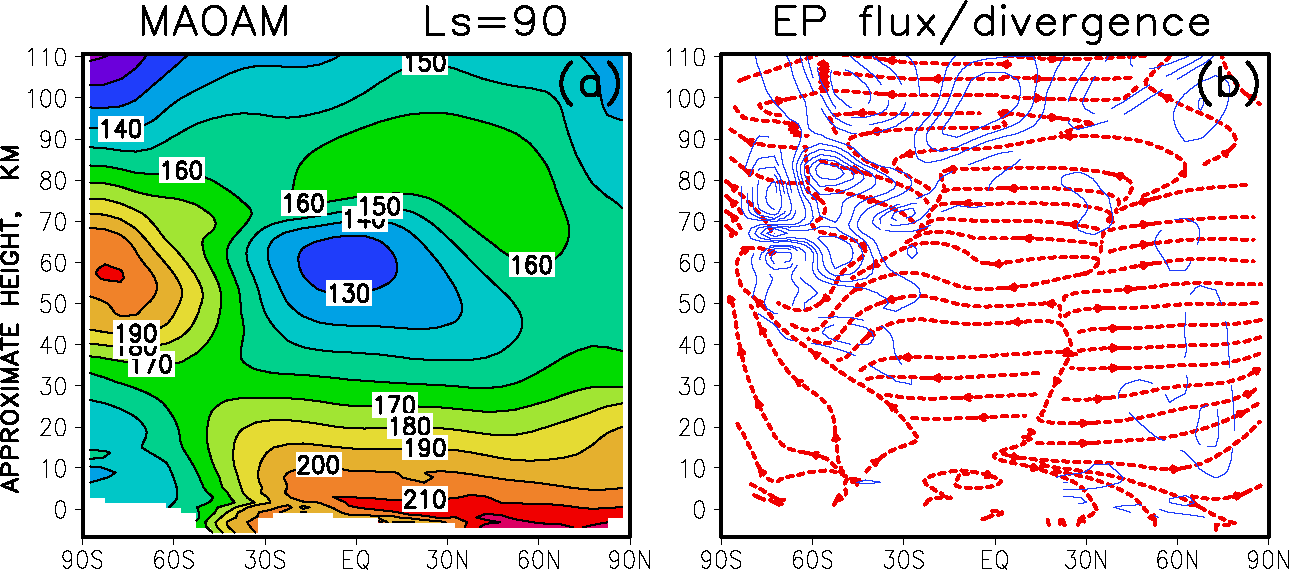
This figure shows the zonal mean temperature for Ls=90 deg (left). A strong winter polar warming is observed around 60 km. Eliassen-Palm (EP) fluxes (bold red arrow lines) show the propagation trajectories of the wave action, and the thin blue lines present the EP flux divergence (right). The plot shows that the topographically generated waves originate near the surface while the thermal tides are excited in the atmosphere at various heights. In the areas of the strong EP divergence/ convergence, the waves deposit their energy and momentum into the mean circulation. The winter polar warming is strongly affected by the waves.

Equatorial diurnal variation of ozone on Mars during summer solstice calculated with the MAOAM chemistry-transport module.
Planetary magnetospheres (the space around a planet where the planetary magnetic field dominates) are large space plasma laboratories where the whole variety of plasma processes can be studied. Especially in-situ measurements of particles, fields and waves aboard spacecraft provide new insights in processes like particle-particle- and wave-particle interactions, particle acceleration or particle precipitation in aurorae. In addition to the interaction between magnetospheric particles and moons, rings and dust the dynamics of these particles, their sources, sinks, and relative abundances could help to significantly enhance the understanding of planetary magnetospheres. The PhD candidates will work on the unique particle data sets of the Galileo and Cassini spacecraft.
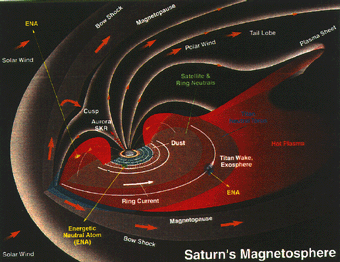
Click on image for larger version
The Rosetta spacecraft will arrive at comet 67P/Churyumov-Gerasimenko in early 2014. The onboard OSIRIS camera system is made up of two cameras with a total of 23 filter combinations, which will be used to take multi-colour images of the comet's nucleus and coma. This PhD project aims to link this colour information to the composition of ices and minerals on the surface, and gasses/ice/dust in the coma, by developing models of what signatures to expect for likely comet components. In addition to differences in composition, the measured brightness of surface components will depend on surface material properties (e.g. grain size) and illumination (local phase angle). The photometric models developed to interpret the OSIRIS data will also take these into account. In the latter part of the project these models will be used to interpret the data from Rosetta, i.e. mapping areas of different composition on the surface. Before arrival at the comet the models will be used to interpret the integrated flux from the comet as observed from ground based telescopes.
[top]One of the key questions we want to investigate on comets concerns the activity of the nucleus. It has been known for decades that this process is driven by solar illumination, sublimating the ice present at the surface or subsurface of the nucleus. However, it is also known that the activity is usually concentrated in very localized areas of the surface, some of them remaining active even when not illuminated. In support of the Rosetta mission, we are developing a complex model of cometary activity, simulating all physical processes that lead to the creation of "jets" of dust and gas from these active areas. In this context, we want to understand more how the temperature of the surface and subsurface evolves in the active phase of the comet orbit, and we want to develop a complete 3D thermal model of the nucleus, to account precisely for the influence of topography on the diurnal activity.
Another question that needs to be answered is how the local topography affects the activity after the sublimation phase. It is generally assumed that gas will flow around the nucleus and expends into space, and several model have been attempted to describe this, but mainly restrained to ideal cases. We would like to develop here the first full 3D model of gas flows around a cometary nucleus, taking into account the influence of local topography and diurnal variations of temperature associated. This will lead to a better understanding of cometary activity at the surface of the nucleus and the inner coma.
Both students will work in the "Small Bodies working group" at the MPS, where there is already experience and support in observing and modeling physical properties of comets, plus strong implication in several leading instruments of the Rosetta mission. The work is mainly theoretical but students will have access to spacecraft data to test the models.
[top]
Illustration of Rosetta's approach towards comet 67P/Churyumov-Gerasimenko, the lander Philae delivery in Nov 2014 and an example of the envisaged solar wind plasma hybrid simulations
The Microwave Instrument for the Rosetta Orbiter (http://www.mps.mpg.de/de/projekte/rosetta/miro/#contribution) is the first radio telescope flown on a "deep space" mission. Since its launch in March 2004, MIRO has already observed a comet and (during the Rosetta Earth fly by in March 2005) provided valuable data about the composition of Earth upper atmosphere. On July 4 of this year (2005) MIRO will observe the increase in water production of Comet 9P/Tempel 1 after the Deep Impact spacecraft has crashed on the comet. MIRO operates in the millimeter and submm domain of the electromagnetic spectrum and observes water and its isotopes, carbon monoxide, ammonia and methanol. The extremely high spectral resolution of 10-7 enables the instrument to exactly determine the spectral line shapes of these molecules and measure their Doppler shifts. Since the distance of the Rosetta spacecraft from the cometary nucleus is so small, MIRO will measure spectral line shapes never seen before and provide completely new clues about processes happening in the inner coma of a comet. MIRO will for instance identify active areas on the cometary nucleus and exactly determine their molecular dependent outgassing rate (via the line strengths) and the velocity distribution (via Doppler-profile/shift). Furthermore MIRO will provide temperature profiles within the inner coma (excitation state of methanol lines) and information about the hydrodynamic of gas jets. The goal of this PhD project is to simulate the molecular spectra we expect to observe with MIRO as a function of the distance from and view on the comet and vice versa to investigate how exactly the input parameters of the simulation can be retrieved from the spectra.
[top]MPS has more than 20 years experience in the development of Chirp Transform Spectrometers (CTS). These spectrometers have been used in ground-based, air- and spaceborne millimeter- and submillimetre wave heterodyne experiments. The Chirp Transform (CT) is equivalent to the Fourier Transform. The algorithm describes how to implement a Fourier Transform using linear dispersive pulses and their matched filters. CTSes have several advantages compared to other spectrometer concepts leading to superior measurement accuracy. At the same time a CTS can be designed in a way that mass and power consumption is very small compared to other techniques - an important advantage for space borne applications. The key components in presently used CTSes are the so called surface acoustic wave (SAW) dispersive delay lines (DDLs). The SAW-DDLs are passive signal processing devices. The signal processing capability is achieved by the interaction of surface acoustic waves with sub-´m structures on a piezoelectric substrate. The purpose of this PhD project is to investigate how the maximum CTS- bandwidth of presently 400 MHz can be extended and to find out the physical and technical limits. The project phase I will focus on the design, fabrication and test of new ultra-high time-bandwidth-product DDLs, based on classical materials like LiNbO3, phase II on the investigation of new materials (like for instance TiO2) for this purpose and phase III on testing these new devices in a newly designed CTS. The project will be done in collaboration with PTB ( http://www.ptb.de/index_en.html) and it is assumed that the PhD student will perform his studies to about 50 % of his time there. PTB provides modern high resolution electron beam lithography, metallization and dry etching techniques and is experienced in the production of high frequency SAW, resp. single electron tunneling devices (http://www.ptb.de/en/org/2/25/253/verweis/_sing_electr_transp.htm).
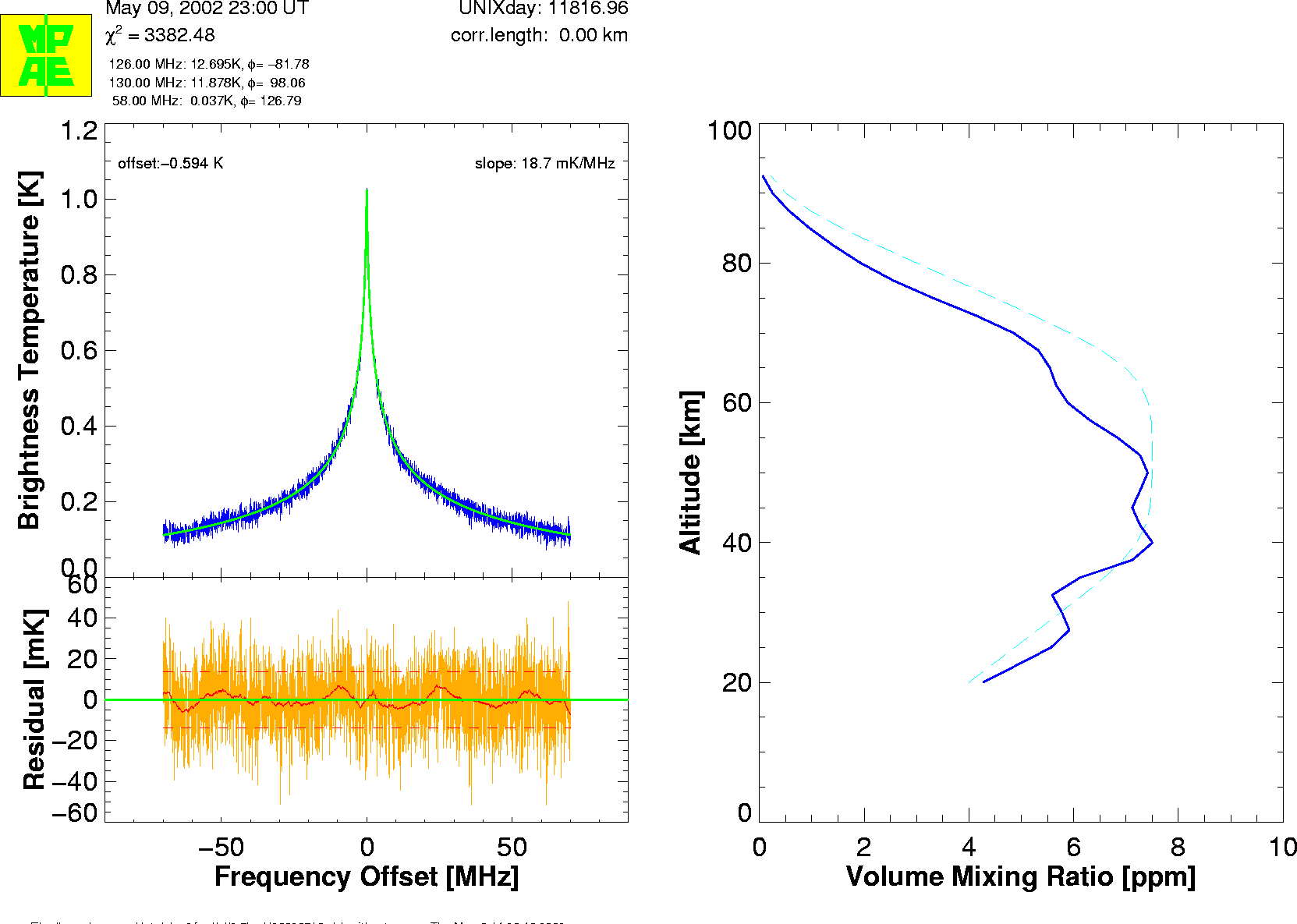
Water vapour spectrum at 22 GHz measured with CTS and retrieved vertical profile of water vapour.
Modern observations of solar system bodies can reveal information concerning the composition, density and size distribution of the regolith covering planetary, lunar, asteroidal and cometary surfaces. The flyby of ESA's ROSETTA spacecraft by the asteroid Steins in September 2008 shall be used for the determination of mechanical regolith properties, such as the angle of repose, maximum slope angles and the occurrence of avalanches on Steins. The successful participant will work at the MPS within the OSIRIS team; supporting laboratory experiments on regolith behavior under low-gravity conditions shall be carried out in collaboration with the TU Braunschweig team so that the data analysis from the Steins flyby can be based on a strong physical background.
[top]We focus on the problem whether, where and under which conditions there is water ice on Mars. Research in this area is experiencing a significant rise in the recent years, which is primarily due to the success of recent space missions to Mars. The data obtained by the Gamma-Ray Spectrometer onboard Mars Odyssey were of great importance. This instrument found hydrogen less than one meter beneath the Martian surface. Hydrogen-rich regions are located in areas where ice should be stable. The ice-rich layer beneath the surface was found even at 60 degrees southern latitude. The other important results were delivered by the Phoenix lander. The robotic arm exposed bits of ice by digging a trench into the soil. Crumbs of bright material initially photographed in the trench later vanished, which indicates that they must have been vaporized after being exposed to solar illumination. Finally, laboratory tests aboard the lander have directly identified water vapor in a soil sample delivered by the robotic arm. Thus, there is clear evidence that water ice exists both in the south and north polar regions of Mars. The theoretical prediction that water ice might be conserved very close to the surface was done by Skorov et al. (2001b) for the south polar layered deposits of Mars. Recently the computer model describing the evolution of surface frost and ground ice concentration in a small-scale trench in a north polar region of Mars was developed by Kossacki and Markiewicz (2009). Although encouraging results explaining some details of surface layer evolution were obtained, there are many open questions concerning the transport processes in surface and water cycle on Mars. The main efforts will be focused on investigations of the heat propagation into porous soil and on the long-term stability of ice beneath various non-volatile layers. The important specific feature of the planned research is the close interaction between the laboratory experiments and the extended computer simulations.
[top]The main goal of this project is investigation of the distant activity of a new class of objects, which have features of both, comets (e.g., gas activity) as well as asteroids (orbital characteristics). These are the so-called main belt comets (Hsieh and Jewitt 2006) or dynamical asteroids with mass loss. Very recently, two independent teams of observers obtained strong evidence that 24 Themis, one of the largest asteroid in the main belt, has a particularly good match for frost of water ice on the surface (Rivkin and Emery 2010). On the basis of observed infrared spectra Campins et al. (2010) draw even stronger conclusions that water ice is distributed across the asteroid surface. It is worth noting that three of the earlier observed main belt comets are members of the Themis dynamical family. Thus, it can be assumed that water ice is a common constituent of these objects and that their observed activities are driven by ice sublimation. As the lifetime of open water ice is rather short at this distance (~3 AU), the steady migration of water through high-porosity media from the asteroidÆs interior to the surface and/or small impacts with asteroid belt boulders puncturing the porous dust layer and expose fresh ice could explain the observations. These recent discoveries will surely trigger a new wave of interest in the modeling of heat and mass transfer in asteroids and comets at large heliocentric distances. The main efforts will be focused on investigations of the long-term stability of ice beneath various non-volatile layers as well as on analysis of collisions of small bodies with porous media. The important specific feature of the planned research is the close interaction between the laboratory experiments, observations and the extended computer simulations.
[top]Fractal dust aggregates play an important role in the formation of planets. When protoplanetary dust particles collide at low velocities, the growing agglomerates are extremely fragile. It is an unsolved problem at which stage of the protoplanetary-dust growth these open-structured agglomerates are being compacted. In this project, we will perform unique laboratory experiments on the collision behavior of fractal dust aggregates. The laboratory at the Institute for Geophysics and extraterrestrial Physics at TU Braunschweig is a world-leading place for such experiments. In close collaboration with modelers from the University of Tübingen, we will investigate under which physical conditions fractal dust aggregates are compactified or fragmented in mutual collisions.
[top]Water ice is a major constituent in the outer Solar System. When the planetary bodies in the outer reaches of the protoplanetary disk formed, collisions among ´m-sized ice particles were frequent. Due to the relatively high surface energy of water ice, it is expected that the sticking efficiency in collisions among water-ice particles is much higher than for the well-investigated silicate particles. With a new and unique experimental setup we intend to study the impact behavior of ´m-sized water-ice particles at cryogenic temperatures to deduce the velocity range in which water-ice particles can grow towards planetesimals or cometesimals. The results will have important impact on the understanding of planet formation in protoplanetary disks.
[top]Our knowledge about physical properties of stars almost exclusively comes from spectroscopy, and spectroscopic absorption lines carry enormous information about stellar surface structure - e.g. spots, velocities and magnetic fields. Absorption lines are densely packed in cool stars (like the Sun) blurring the information contained in the line shape. Techniques to reconstruct such information are being widely used nowadays but are still in their infancy. One goal is to improve techniques reconstructing stellar absorption profiles, and apply them to high quality astronomical data - more and more of which become available thanks to the growing number of telescopes providing high resolution spectra. On the other hand, individual spectral lines are compared to theoretical models of stellar atmospheres. Improvements of such models can, e.g., include the calculation of magnetic field signatures in rotating stars.
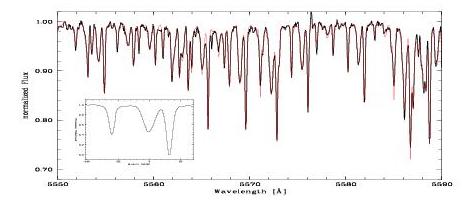
Successful reconstruction of line broadening in a stellar triple system.
The most frequent stars in our galaxy are cool stars of spectral type M. Their faintness makes detailed investigation difficult, and surprisingly few is known about their atmospheric structure. At such low temperatures, molecules dominate the visual and infrared spectra and become the most significant tracers of stellar atmospheres. Molecular bands, however, are much more complex than atomic lines and their fundamental constants are difficult to measure in the laboratory or to calculate ab-initio. On the other hand, molecular bands are very temperature sensitive and it is possible to measure fundamental molecular constants from astrophysical observations. Spectroscopic data for such measurements has become available through 10m class telescopes providing high quality data even for very faint stars. Molecular constants, once measured, will improve theoretical calculations of stellar atmospheres, and allow an accurate characterization of very cool M-star atmospheres.
[top]Several magnetohydrodynamics experiments are currently in operation or under construction (see the figure), which are intended to reproduce on a laboratory scale the mechanisms relevant to dynamo action in planetary cores or stars. All these experiments face the question as to what can be learnt from them about the geophysical or astrophysical problem they are supposed to explore. Numerical simulations are necessary in order to identify the characteristics common to experimental dynamos and dynamos occuring in nature. A possible topic of a PhD thesis is the investigation of the influence of turbulent fluid motion on dynamo action.
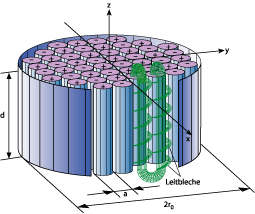

The basic problem is delineated in the figure. The earth consists approximately of three layers: the inner core (IC), the outer core, and the mantle. Outer core and mantle meet at the core mantle boundary (CMB). The outer core, i.e. the region inbetween rIC and rCMB, is liquid. The motion of this liquid (mostly iron) is believed to be at the origin of the earth's magnetic field. The earth revolves once a day about the axis joining geographic north and south poles, and this axis itself precesses about the normal to the ecliptic which forms an angle of 23.5o with the diurnal rotation axis. The problem is to determine the fluid flow inside the outer core driven by the precessional motion of the solid boundaries. This flow could participate in the generation of the Earth's magnetic field. Another problem is the determination of the long term evolution of the earth-moon-sun system if the dissipation due to precession is taken into account.
The fluid motion driven by precession is also relevant for satellite dynamics, for instance when a manoever needs to be planned in which the spin axis of a spin stabilized satellite containing liquid fuel is reoriented.
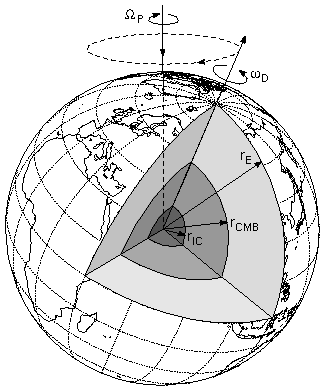
Turbulent convection is an ubiquitous phenomenon in geophysics and astrophysics, frequently in a rotating fluid or under the influence of a magnetic field. Even the simplest case of Rayleigh-Benard convection is not fully understood. The focus is at present on coherent large scale structures which persist in the presence of small scale turbulent fluctuations.
